MBL 116 Radialstrahler Elegance Loudspeaker
| MBL 116 Radialstrahler Elegance Loudspeaker |
| Elegance Defined |
|
|
|
November 2007 |
“If you can imagine the sheer bloody pleasure of having an idea and taking it! It’s one of the great pleasures of my life. My god, an idea!
Author Doris Lessing
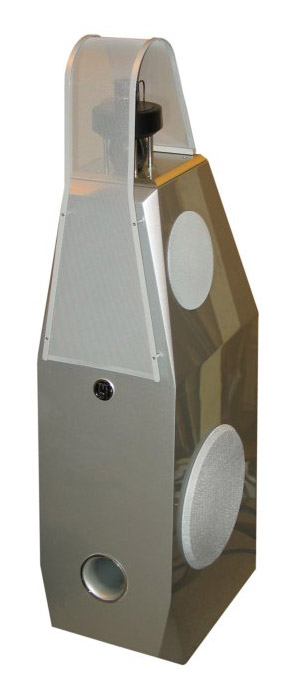 Wolfgang Meletsky, the founder of mbl, invented an astonishing new idea for designing loudspeakers. It was called the “Radialstrahler,” a dynamic driver composed of numerous carbon segments that would bend and flex in response to an applied signal. The Radialstrahler design concept forms the centerpiece to mbl’s flagship loudspeaker, the 101 E, which incorporates a 24 segment carbon fiber Radialstrahler tweeter and a smaller, 12 segment upper Radial midrange driver. Many of us have gawked at the massively beautiful 101 E at various shows. If lucky, we heard the 101 E at its best, delivering its effortless clarity, immediacy and resolving power within an unbounded soundstage. Now, the mbl design team, (headed by their chief designer, Jurgen Reis), has taken the idea of the Radialstrahler one step further by incorporating its drivers into smaller loudspeaker designs and enclosures. The Model 116 Elegance (“116”) is the newest foray by mbl into their continuing exploration of the Radialstrahler design idea. I set out to discover whether the 116 would prove to be a true music-maker in my listening room, or simply a gorgeous projection.
Wolfgang Meletsky, the founder of mbl, invented an astonishing new idea for designing loudspeakers. It was called the “Radialstrahler,” a dynamic driver composed of numerous carbon segments that would bend and flex in response to an applied signal. The Radialstrahler design concept forms the centerpiece to mbl’s flagship loudspeaker, the 101 E, which incorporates a 24 segment carbon fiber Radialstrahler tweeter and a smaller, 12 segment upper Radial midrange driver. Many of us have gawked at the massively beautiful 101 E at various shows. If lucky, we heard the 101 E at its best, delivering its effortless clarity, immediacy and resolving power within an unbounded soundstage. Now, the mbl design team, (headed by their chief designer, Jurgen Reis), has taken the idea of the Radialstrahler one step further by incorporating its drivers into smaller loudspeaker designs and enclosures. The Model 116 Elegance (“116”) is the newest foray by mbl into their continuing exploration of the Radialstrahler design idea. I set out to discover whether the 116 would prove to be a true music-maker in my listening room, or simply a gorgeous projection.
A Challenging Vision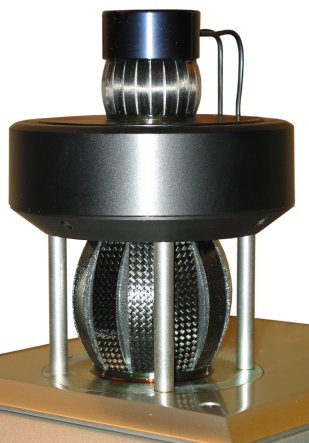 The 116 is a four way design and shares many of the same Radial technologies with its big brother, the 101 E, including a Radialstrahler tweeter unit and midrange unit specifically designed by mbl. These Radial drivers are mated with dual push-pull 5.5 inch woofer units and dual 8 inch subwoofer drivers all designed and built in house by mbl. According to company literature, the 116’s frequency range is from 32Hz-33000Hz with an impedance of 4 ohms. Bi-wiring is essential. The 116 proved to be eye-catching, with beautifully crafted and finished enclosures. My pair arrived well packed in gleaming and flawless piano finish, quite befitting of loudspeakers in this costly price range. The curvaceous metal grills provided were beautiful to look at but, if left in place, resulted in a slight dampening of the 116’s otherwise airy and spacious presentation.
The 116 is a four way design and shares many of the same Radial technologies with its big brother, the 101 E, including a Radialstrahler tweeter unit and midrange unit specifically designed by mbl. These Radial drivers are mated with dual push-pull 5.5 inch woofer units and dual 8 inch subwoofer drivers all designed and built in house by mbl. According to company literature, the 116’s frequency range is from 32Hz-33000Hz with an impedance of 4 ohms. Bi-wiring is essential. The 116 proved to be eye-catching, with beautifully crafted and finished enclosures. My pair arrived well packed in gleaming and flawless piano finish, quite befitting of loudspeakers in this costly price range. The curvaceous metal grills provided were beautiful to look at but, if left in place, resulted in a slight dampening of the 116’s otherwise airy and spacious presentation.
Given its omni directional design, the 116 presents significant challenges to proper room placement. The 116’s radiation pattern will excite any room node or untreated, reverberant room to a striking degree. Careful attention to room placement and treatment is absolutely essential. Anticipate that this speaker loves the long wall of a room. If placed along the short wall, I found it sounded congested, particularly in the midrange, with much less immediacy and clarity. The 116 also required plenty of unrestricted space to sound its best. Quite shocking was the early discovery that the 116 is a very good near-field listening loudspeaker. I expected just the opposite, but my favorite listening position was at the base of an imagined triangle, just seven feet from the speakers, which were spread 8 feet apart, and distanced several feet from side and back walls. My success with near field listening bodes well for recommending this speaker in a medium sized room. Also be aware that the 116 is very revealing of associated equipment and requires lots of amplifier power behind it to sound its best. The 500 watts per side McIntosh 501 monoblocks were the best amplifier match I had on hand for the 116. The 116 revealed all nuances in associated equipment, including cable selections. For speaker cables, I found that the TARA Labs “The One” speaker cable was the best match with the 116, conveying the glorious size and weight of the 116’s airy soundstage. To summarize, you absolutely need the right combination of associated equipment and careful room placement to approach what the 116 and its omni directional design have to offer. The manual provided by mbl is comprehensive but I found it far from conclusive for guiding individual room placement. Be prepared for a lot of experimentation in its placement with your own ears as a guide. Also, do seek the guidance of mbl on these critical setup issues posed by the 116.
A Holographic Vision
The inventor of Holography, the Nobel Prize physicist Dr. Dennis Gabor, once commented that “the best way to predict the future is to invent it.” I have to believe that mbl’s design team took a bit of inspiration from Gabor because their 116 provides the closest I have heard to a Holographic work of art in a loudspeaker, one that sings and breathes as well. Optimally placed and with the right associated equipment, the 116 approaches the most cinematic, viscerally felt and effortless spacious presentation I have ever experienced in a loudspeaker. The overall characteristics are an effortless resolving power, with no strain at high SPL’s and a compelling visual experience listening to recorded music. What the 116 achieves at its best is a huge soundstage, with image size and focus absolutely natural and convincing. You never get the feeling that you are watching a performance on an IMAX theatre screen – imaging is absolutely natural in height and dimension. Moreover, the glory of this immense soundstage, (with its naturally drawn musicians), does not diminish when you move about the room. The 116 is seamless from top to bottom, with a power of transparent resolution, speed and effortless image clarity that is brilliant, both in music’s big flourishes as well as in its minute, filigree details.
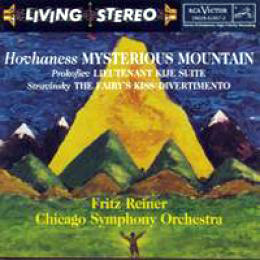 A fine example of this was listening to the grand vision of Alan Hovhaness, in his majestic piece,Mysterious Mountain[Living Stereo 61957-2]. Mysterious Mountain is truly awe inspiring, as it moves from solemn hymns to a fiercely played second movement, with strings using “counter-subject and triple counterpoint episodes.” There are also great flourishes of orchestral color, fragile solos by woodwinds and crystalline bells that ring in the airy rear of the soundstage. (It is fascinating to note that Hovhaness conceived of the third movement of this piece after taking a nap and dreaming about its musical possibilities and ideas. He later corrected parts of this score after a second dream he had a few days later.) With the 116 in place, Hovhaness’ beautiful vision became truly a visceral, cinematic experience. The rear wall of my room disappeared completely, leaving behind a sweeping soundstage where individual instruments hung in airy, three-dimensional space. The 116 placed me in a mid-orchestra seat, right in the middle of all of the orchestral flourishes and drama. The hall ambiance was breathtakingly real. The natural size and image definition of each section of the orchestra was illuminated. Listening to this piece also illustrated the thunderous low octave dynamics the 116 was capable of summoning. The 116 was exceptional in providing bass depth and revealing that special seamlessness between low, mid and upper bass with no feeling of loss or compression. It had tremendous freedom in these lower regions, with no sense of over-damped constriction and a tremendous movement of air underneath – the best I had experienced in my room. The McIntosh 501’s special quality with double string bass rolling into the room was conveyed in all of its naturalness and drama by the 116.
A fine example of this was listening to the grand vision of Alan Hovhaness, in his majestic piece,Mysterious Mountain[Living Stereo 61957-2]. Mysterious Mountain is truly awe inspiring, as it moves from solemn hymns to a fiercely played second movement, with strings using “counter-subject and triple counterpoint episodes.” There are also great flourishes of orchestral color, fragile solos by woodwinds and crystalline bells that ring in the airy rear of the soundstage. (It is fascinating to note that Hovhaness conceived of the third movement of this piece after taking a nap and dreaming about its musical possibilities and ideas. He later corrected parts of this score after a second dream he had a few days later.) With the 116 in place, Hovhaness’ beautiful vision became truly a visceral, cinematic experience. The rear wall of my room disappeared completely, leaving behind a sweeping soundstage where individual instruments hung in airy, three-dimensional space. The 116 placed me in a mid-orchestra seat, right in the middle of all of the orchestral flourishes and drama. The hall ambiance was breathtakingly real. The natural size and image definition of each section of the orchestra was illuminated. Listening to this piece also illustrated the thunderous low octave dynamics the 116 was capable of summoning. The 116 was exceptional in providing bass depth and revealing that special seamlessness between low, mid and upper bass with no feeling of loss or compression. It had tremendous freedom in these lower regions, with no sense of over-damped constriction and a tremendous movement of air underneath – the best I had experienced in my room. The McIntosh 501’s special quality with double string bass rolling into the room was conveyed in all of its naturalness and drama by the 116.
The Hovhaness piece also illustrated the visceral midrange of the 116, particularly on swells of violas during Mysterious Mountain’s rapid second movement, racing along in all of their perfectly defined space in Chicago’s Orchestra Hall. The timbre of the violas was natural and true, as was the solo oboe in its breathy lower registers in the concluding hymn. This racing second movement did expose a chink in the 116’s dazzling visceral presentation, however. Although the Radial tweeter clearly shown great resolving power and nice upper octave rhythm, there was a perceptible brightness in the highest treble regions. Violins were touched with a slight but perceptible analytical dryness and a lack of full body and warmth in their highest registers. The meandering hymn of the closing trumpet solos was warm and tone perfect in its midsection, but turned slightly too brazen, a bit bright and without proper body in its highest reaches. This may have been the result of uncorrected reflective interfaces between the 116 and my room or a result of how the 116 presents a bit more of an analytical presentation up top in its voicing.
 Moving from Hovhaness to Little Feat was a big, joyous leap with the 116 in place. When listening to the raucous Little Feat, one inevitably pulls out their great live recording, Waiting For Columbus [Rhino 78274]. From the very first deep and resonant congas pushing off “Spanish Moon,” I knew I was in for a visceral, cinematic treat in the hands of the 116. Seamless from top to bottom, powerful and poignant down below, the 116 conjured up the band in absolute human, sweaty three-dimensional form. Snarling guitar from Lowell George was crisp and true, buttered by Kenny Gradney’s articulate and deep bass. The sprightly piano runs of Bill Payne kicking off “Dixie Chicken” were light and twinkling, with accurate tone and crispness. Payne’s solo, (punctuated by the blazing backup horns of the Tower of Power) was perfectly snared by the 116 with all musicians on this crowded stage laid out in precise, airy definition. Once again, all wall boundaries in my room disappeared in this lifelike, holographic presentation.
Moving from Hovhaness to Little Feat was a big, joyous leap with the 116 in place. When listening to the raucous Little Feat, one inevitably pulls out their great live recording, Waiting For Columbus [Rhino 78274]. From the very first deep and resonant congas pushing off “Spanish Moon,” I knew I was in for a visceral, cinematic treat in the hands of the 116. Seamless from top to bottom, powerful and poignant down below, the 116 conjured up the band in absolute human, sweaty three-dimensional form. Snarling guitar from Lowell George was crisp and true, buttered by Kenny Gradney’s articulate and deep bass. The sprightly piano runs of Bill Payne kicking off “Dixie Chicken” were light and twinkling, with accurate tone and crispness. Payne’s solo, (punctuated by the blazing backup horns of the Tower of Power) was perfectly snared by the 116 with all musicians on this crowded stage laid out in precise, airy definition. Once again, all wall boundaries in my room disappeared in this lifelike, holographic presentation.
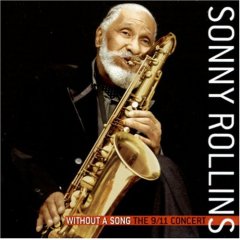 Likewise, when spinning Sonny Rollins’ inspired set captured on his Without A Song The 9/11 Concert [Milestone 93422], the 116 brought the live venue (here, Boston’s Berklee Performance Center) right into my listening room with a naturalness in scale and height that was shockingly real. Listening critically into that immense soundstage, however, there were some kinks in this seamless presentation. Noted again was a slight rolling off, or overly bright sheen to Rollin’s tenor climbing into the highest treble regions. Cymbals too sounded a bit peaked and dry, without full body and natural weight in their crested splashes. A bit contradicting, I felt drawn directly into the immense and lifelike soundscape rendered by the 116 in this live performance, but also came away feeling slightly removed from its passion as a result of the 116’s more analytical approach, with a dominating crystalline precision, (rather than inviting warmth and true tone) up top. Same was true of that wonderful, rollicking Bruce Springsteen, on “Old Dan Tucker” from his brilliant We Shall Overcome, The Seeger Sessions [Columbia 82867]. The 116 was timbre and tone perfect on all husky deep vocals and acoustic guitar licks, creating a most convincing soundstage for this living room concert unfolding right before my ears (and slippers). The 116 was again shockingly brilliant in its clarity and image focus but a bit bright and crystalline up top in its tonal treatment of twinkling banjo and violin.
Likewise, when spinning Sonny Rollins’ inspired set captured on his Without A Song The 9/11 Concert [Milestone 93422], the 116 brought the live venue (here, Boston’s Berklee Performance Center) right into my listening room with a naturalness in scale and height that was shockingly real. Listening critically into that immense soundstage, however, there were some kinks in this seamless presentation. Noted again was a slight rolling off, or overly bright sheen to Rollin’s tenor climbing into the highest treble regions. Cymbals too sounded a bit peaked and dry, without full body and natural weight in their crested splashes. A bit contradicting, I felt drawn directly into the immense and lifelike soundscape rendered by the 116 in this live performance, but also came away feeling slightly removed from its passion as a result of the 116’s more analytical approach, with a dominating crystalline precision, (rather than inviting warmth and true tone) up top. Same was true of that wonderful, rollicking Bruce Springsteen, on “Old Dan Tucker” from his brilliant We Shall Overcome, The Seeger Sessions [Columbia 82867]. The 116 was timbre and tone perfect on all husky deep vocals and acoustic guitar licks, creating a most convincing soundstage for this living room concert unfolding right before my ears (and slippers). The 116 was again shockingly brilliant in its clarity and image focus but a bit bright and crystalline up top in its tonal treatment of twinkling banjo and violin.
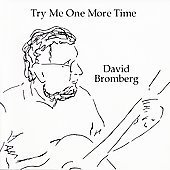 Finally, the 116 brought its amazing gifts of spacious believability to smaller scale recordings just as beautifully. For example, David Bromberg’s sly wit, meandering deep voice and beautifully crafted guitar on his new recording, Try Me One More Time [Appleseed Recordings 1099] were delivered in rich, visceral form by the 116. Each note from Bromberg’s guitar was delivered in its full voice, from its onset to its decay. There was effortless clarity here, a visceral immediacy to the recording that was riveting. Another ravishing performance was that by the playful vocalist, Datevik, from her beautiful Mapleshade recording (Datevik) performed with the Larry Willis Quartet. On “Desafinado,” the 116 captured everything in high resolution from Larry Willis’ sparkling light piano to Andy McCloud’s punctuated deep bass. The walls of the small Mapleshade recording were brilliantly conveyed by the 116 as well. The only hint of problems was that touch of dryness, a bright sheen and loss of true timbre to Datevik’s highest vocal reaches, otherwise fluid and true down below. Listening to pianist Anat Fort’s intimate exploration, A Long Story[ECM 8505-02], I was drawn into an enveloping, gorgeous soundstage by the 116, as expected. The 116 had a special way with resolving the inner, minute details offered on this recording, from the soft tactile pluck of Ed Schuller’s double bass to Paul Motian’s muscular drum and brushwork. Compared to my reference Ascendo loudspeaker, the 116 clearly afforded more soundstage depth and width, bass presence, natural air, immediacy and that special magic in giving each player the natural air and stage space they occupy on this recording. However, I still felt that the presentation was a bit analytical compared to the Ascendo’s. With the Ascendos, I found myself more drawn in and emotionally invested in the creative action in this special recording session with Fort and her band. The difference was again sensed most up high, with the Ascendo’s ribbon tweeter offering a warmer and at times, truer tone to Fort’s light explorations at the top of her piano keyboard, while the 116 offering a more analytical, crystalline resolve up top.
Finally, the 116 brought its amazing gifts of spacious believability to smaller scale recordings just as beautifully. For example, David Bromberg’s sly wit, meandering deep voice and beautifully crafted guitar on his new recording, Try Me One More Time [Appleseed Recordings 1099] were delivered in rich, visceral form by the 116. Each note from Bromberg’s guitar was delivered in its full voice, from its onset to its decay. There was effortless clarity here, a visceral immediacy to the recording that was riveting. Another ravishing performance was that by the playful vocalist, Datevik, from her beautiful Mapleshade recording (Datevik) performed with the Larry Willis Quartet. On “Desafinado,” the 116 captured everything in high resolution from Larry Willis’ sparkling light piano to Andy McCloud’s punctuated deep bass. The walls of the small Mapleshade recording were brilliantly conveyed by the 116 as well. The only hint of problems was that touch of dryness, a bright sheen and loss of true timbre to Datevik’s highest vocal reaches, otherwise fluid and true down below. Listening to pianist Anat Fort’s intimate exploration, A Long Story[ECM 8505-02], I was drawn into an enveloping, gorgeous soundstage by the 116, as expected. The 116 had a special way with resolving the inner, minute details offered on this recording, from the soft tactile pluck of Ed Schuller’s double bass to Paul Motian’s muscular drum and brushwork. Compared to my reference Ascendo loudspeaker, the 116 clearly afforded more soundstage depth and width, bass presence, natural air, immediacy and that special magic in giving each player the natural air and stage space they occupy on this recording. However, I still felt that the presentation was a bit analytical compared to the Ascendo’s. With the Ascendos, I found myself more drawn in and emotionally invested in the creative action in this special recording session with Fort and her band. The difference was again sensed most up high, with the Ascendo’s ribbon tweeter offering a warmer and at times, truer tone to Fort’s light explorations at the top of her piano keyboard, while the 116 offering a more analytical, crystalline resolve up top.
Vision Defined
With essential attention given to room placement and associated equipment, the 116 offers an unparalleled listening experience in the specific areas of its astounding three dimensional soundstage, tactile recording ambiance, effortless speed and resolving power, precise image focus and a special way with immediacy. Whether such visceral, truly holographic loudspeaker presentation is the reference standard in true music making and timbre reproduction, (getting one closer to the intention of the artist), is still open to debate. However, within the confines of its particular Vision, the 116 is a reference loudspeaker product, bringing a visceral excitement to favorite recordings that is indeed infectious, fueled by its truly spectacular, three-dimensional Radial Vision.

__________________
Specifications
System: 4 way
Frequency range: 32Hz-33000Hz
Impedance: 4 ohms
Crossover frequencies: 130Hz, 600 Hz, 3500 Hz Linkwitz-Riley, 4th order
Power handling: continuous 350W/450W; peak 1800W
Sub-woofer: 2×200 mm 8 in.
Woofer: double push-pull 2x140mm 5.5 in.
Dimensions: 11W x 47″H x 17″D
Weight: 88 pounds
Finishes Available: satin; black or artic silver; piano
Price: $20,500 – satin finish; $21,700-piano finish
Company Information
MBL of America
17 Windswept Way
Mission Viejo, CA 92692
(949) 331-3147
www.mbl-usa.com
![]()
Don’t forget to bookmark us! (CTRL-SHFT-D)
Stereo Times Masthead
Publisher/Founder
Clement Perry
Editor
Dave Thomas
Senior Editors
Frank Alles, Mike Girardi, Russell Lichter, Terry London, Moreno Mitchell, Paul Szabady, Bill Wells, Mike Wright, and Stephen Yan,
Current Contributors
David Abramson, Tim Barrall, Dave Allison, Ron Cook, Lewis Dardick, John Hoffman, Dan Secula, Don Shaulis, Greg Simmons, Eric Teh, Greg Voth, Richard Willie, Ed Van Winkle, Rob Dockery, Richard Doran, and Daveed Turek
Site Management Clement Perry
Ad Designer: Martin Perry





Be the first to comment on: MBL 116 Radialstrahler Elegance Loudspeaker